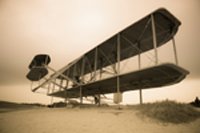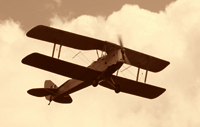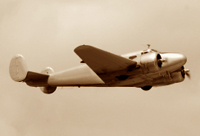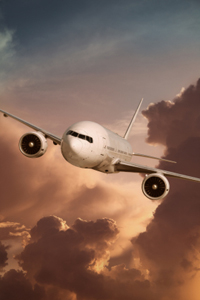A Brief History of Airplanes
and Aviation Safety
The history of airplanes and helicopters in aviation is still a relatively short chapter. However, the amount of progress between the Wright brothers first flight and current aviation is nothing short of amazing.
The leap in aviation technology can be attributed to the advancement in computer technology and the demand for safer and more efficient airplane designs for war, business, and air travel.

No history of aviation is complete without mention of the Wright brothers. While there were numerous prior aircraft designs and flight attempts, the Wright brother’s airplane design would set the standard for the future. Their 12-second flight in 1903 was the first controlled, engine-powered flight with a heavier-than-air aircraft (as opposed to balloons and blimps). It's when the history of airplanes really began.
A New Era
 World War One
World War One (1914-1918) ushered in a new era of flight.
Pilots began to need a system for communicating with their commanders and ground personnel, and the first communications equipment was invented - the radiotelephone.
The standard materials of wood and fabric were replaced by aluminum, which was lighter, stronger, and safer. As capturing new flight records and performing acrobatics became popular, biplanes were phased out for the development of monoplanes, which were sleeker and more maneuverable.

By the onset of World War Two (1939-1945) flight instruments had been invented, airplanes were equipped with radar, and the first jet engine was already in production.
Following the world wars, the age of jet airliners began, as airline companies like Pan Am and airplane manufacturers like Boeing combined to transport millions of passengers around the world. High cruising altitudes and transoceanic flights were the results of improved aerodynamics, aircraft metal types, and improvements to the engines.
Airplane design has remained relatively consistent since then, with the majority of major changes coming from new electronic systems and composite structures, in response to the increased need for efficiency in communications, navigation and aircraft operating costs.
History of Airplane Design

The single greatest step in the history of airplane design was the
introduction of the turbine powered engine. These engines transformed the aviation world, by drastically increasing the speed, rate of climb, maneuverability, and distance traveled. All large transport aircraft are equipped with more than one engine, so if one engine fails there are back-up engines that will provide enough power for a safe landing.
Along with turbine powered engines came the need for cabin pressurization. A cabin pressurization system allows an airplane to safely ascend to a high altitude cruising level while maintaining a low altitude level inside the cabin for passenger comfort.
High altitude cruising is more efficient and keeps the airplane above most bad weather and turbulence, making the trip more comfortable for passengers and crew, as well as lessening the stress on the airplane.
Current changes in airplane design include the use of technologically advanced communications, radar, global positioning systems (GPS), and autopilot systems.
These help pilots navigate busy airways and fly safely around severe weather. The autopilot and various alert systems are not a replacement for hands-on flying, but aid the pilot by providing flight assistance as needed so other flight management tasks can be accomplished.
For more information and updates regarding the history of airplanes, subscribe to our free newsletter.
Was this information useful? Please pay it forward. Here's how..
Would you prefer to share this page with others by linking to it?
- Click on the HTML link code below.
- Copy and paste it, adding a note of your own, into your blog, a Web page, forums, a blog comment,
your Facebook account, or anywhere that someone would find this page valuable.